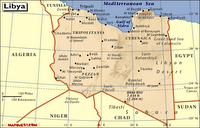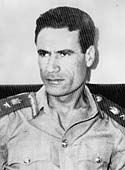An Egyptian Baha'i: In Search Of Recognition (Cont. 1)
 In 1970, a book titled "Baha'ism between Shari'ah and Law" was published about Mustapha's litigation. Its author was Ali Ali Mansour, the Chief Justice of the Administrative Court who ruled on the lawsuit in 1952. At the time of its publication, Justice Mansour was holding the position of Chief Justice of Libya's Supreme Court, and prior to that, he was the Chief Justice of Cairo's Court of Appeals.
In 1970, a book titled "Baha'ism between Shari'ah and Law" was published about Mustapha's litigation. Its author was Ali Ali Mansour, the Chief Justice of the Administrative Court who ruled on the lawsuit in 1952. At the time of its publication, Justice Mansour was holding the position of Chief Justice of Libya's Supreme Court, and prior to that, he was the Chief Justice of Cairo's Court of Appeals.
In his book, he was clearly biased against the Baha'is. He had documented in writing how he really felt about the Baha'i Faith and its followers. Except for the introduction, the 54 page book was a reproduction of his published court opinion of 1952.
In his introduction, he claimed that the purpose of the lawsuit was not as much for its financial rewards, but rather it was intended to obtain a judgement that would legalize 'that religion' in Egypt and to make Baha'i marriages legal under the laws of the country. He also stated that the court had asked the plaintiff to provide it with the Baha'i Holy books, but instead of elaborating on the content of the material provided to the court, he repeated the usual false accusations that had been circulating in Egypt by enemies of the Baha'i Faith for several decades. He claimed that Baha'is, like Masons, meet secretly, he then wrote that the Masonic movement was an offshoot of Zionism!
He then went on describing his arrival in Libya in 1953, and his meeting with Dr. Gulick (sp?). According to his account, Gulick was an American working in Libya's seaport, who held a doctorate in comparative religion from San Francisco. He wrote that he was under the impression that Dr. Gulick was a Christian who had converted to Islam, who wanted to discuss Islamic laws with him, but later Mansour discovered that Gulick had been a Baha'i, married to Ms. Baheya Farag-Allah, an Iraqi Kurdish Baha'i. He then stated that when he returned to Libya 15 years later, he learned that the Baha'is were very active there when they had been under the protection of its former Prime Minister. With the onset of the Libyan revolution led by Colonel Moammar al-Qadhafi in September 1969, there were demonstrations against the Baha'is, and the mob intended to kill the leader of the Baha'i community in Libya, Dr. Keldany Aany (sp?), a Persian who was ultimately exiled as the revolutionary government had "purified the country of the Baha'is." He then accused the Libyan Baha'is of having been secretly meeting in the American Air Force Base until the base was dismantled by Libya's revolutionary government. On closing his introduction, he stated that this was the "final dissolution" of the Baha'i Faith in the Arab Republic of Libya.
He then stated that when he returned to Libya 15 years later, he learned that the Baha'is were very active there when they had been under the protection of its former Prime Minister. With the onset of the Libyan revolution led by Colonel Moammar al-Qadhafi in September 1969, there were demonstrations against the Baha'is, and the mob intended to kill the leader of the Baha'i community in Libya, Dr. Keldany Aany (sp?), a Persian who was ultimately exiled as the revolutionary government had "purified the country of the Baha'is." He then accused the Libyan Baha'is of having been secretly meeting in the American Air Force Base until the base was dismantled by Libya's revolutionary government. On closing his introduction, he stated that this was the "final dissolution" of the Baha'i Faith in the Arab Republic of Libya.
A very interesting introduction indeed, which raises several points: It appears too coincidental that President Gamal Abdel-Nasser dissolved the Baha'i Faith in Egypt in 1960, and Libya's President al-Qadhafi, a revolutionary student and protege of Nasser, dissolved the Baha'i Faith as soon as he assumed power as Libya's President in 1969.
It appears too coincidental that President Gamal Abdel-Nasser dissolved the Baha'i Faith in Egypt in 1960, and Libya's President al-Qadhafi, a revolutionary student and protege of Nasser, dissolved the Baha'i Faith as soon as he assumed power as Libya's President in 1969.
What was Justice Mansour's role in the dissolution of the Baha'i community of Libya?
Why would Justice Mansour publicly attack the Baha'i Faith in a book written, about an eighteen year old Egyptian lawsuit, while he was still Libya's Chief Justice?
How fair could Justice Mansour have been when ruling on the 1952 lawsuit?
Why would this lawsuit appear in the headlines again 54 years later, as it did in Egypt's "October Weekly" magazine article of 4 June 2006?
To be continued....











No comments:
Post a Comment
Your opinion is valuable. Please share your thoughts.